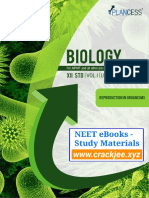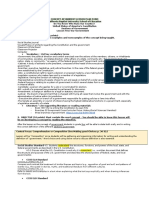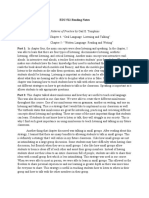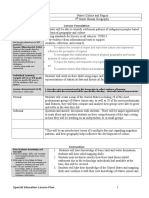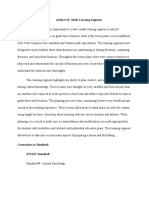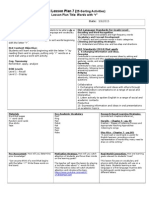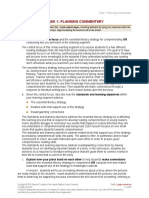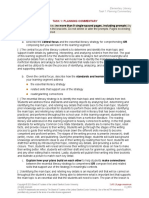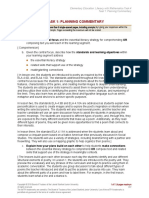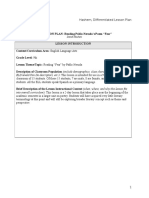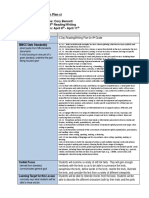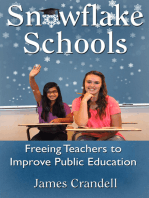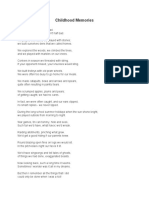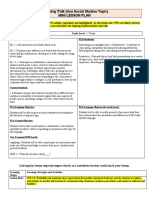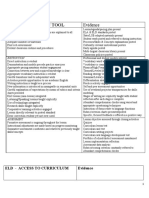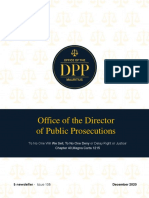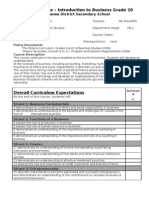Reading Notes 2
Reading Notes 2
Uploaded by
api-5503562950 ratings0% found this document useful (0 votes)
140 views3 pagesThis document outlines the format for reading notes assignments in an EDU 512 class. It discusses key points from two chapters on language arts instruction. Chapter 2 covers different patterns of practice for language instruction, including literature focus units, literature circles, reading/writing workshops, and thematic units. It stresses using multiple approaches and engaging students. Chapter 3 introduces ways to support early literacy development from ages 1-5, including reading aloud and developing understanding of words and phonics. The assignment response summarizes strategies for language arts and social studies, including mini lessons, reading logs, graphic organizers, and learning centers. It also reflects on two TPE standards about critical thinking, meaningful questions, and using knowledge of students to organize curriculum and accommodate individual
Original Description:
Original Title
reading notes 2
Copyright
© © All Rights Reserved
Available Formats
DOCX, PDF, TXT or read online from Scribd
Share this document
Did you find this document useful?
Is this content inappropriate?
This document outlines the format for reading notes assignments in an EDU 512 class. It discusses key points from two chapters on language arts instruction. Chapter 2 covers different patterns of practice for language instruction, including literature focus units, literature circles, reading/writing workshops, and thematic units. It stresses using multiple approaches and engaging students. Chapter 3 introduces ways to support early literacy development from ages 1-5, including reading aloud and developing understanding of words and phonics. The assignment response summarizes strategies for language arts and social studies, including mini lessons, reading logs, graphic organizers, and learning centers. It also reflects on two TPE standards about critical thinking, meaningful questions, and using knowledge of students to organize curriculum and accommodate individual
Copyright:
© All Rights Reserved
Available Formats
Download as DOCX, PDF, TXT or read online from Scribd
Download as docx, pdf, or txt
0 ratings0% found this document useful (0 votes)
140 views3 pagesReading Notes 2
Reading Notes 2
Uploaded by
api-550356295This document outlines the format for reading notes assignments in an EDU 512 class. It discusses key points from two chapters on language arts instruction. Chapter 2 covers different patterns of practice for language instruction, including literature focus units, literature circles, reading/writing workshops, and thematic units. It stresses using multiple approaches and engaging students. Chapter 3 introduces ways to support early literacy development from ages 1-5, including reading aloud and developing understanding of words and phonics. The assignment response summarizes strategies for language arts and social studies, including mini lessons, reading logs, graphic organizers, and learning centers. It also reflects on two TPE standards about critical thinking, meaningful questions, and using knowledge of students to organize curriculum and accommodate individual
Copyright:
© All Rights Reserved
Available Formats
Download as DOCX, PDF, TXT or read online from Scribd
Download as docx, pdf, or txt
You are on page 1of 3
EDU 512 Reading Notes Assignment
EDU 512 Reading Notes Format – Tompkins – (Patterns of Practice):
Name __Chayla Hair ___
Book Title: Language Arts: Patterns of Practice
Chapter Number and Title: Chapter 2 – Teaching and Assessing Language Arts, Chapter 3 –
Emergent Literacy
Do the following:
Part 1:
Chapter 2: Teaching and Assessing Language Arts discusses the importance of using
multiple patterns of practice during language instruction. The four patterns of practice include
literature focus units, literature circles, reading and writing workshops, and thematic units. Both
teacher-led and student-selected instructional patterns provide valuable language-learning
opportunities, but no one approach provides all the opportunities that students need (Tompkins,
2013, p. 30). Literature focus units represent books that all children should read based on their
grade. It is important for students to be interested and engaged during reading and writing
activities. When it has meaning to the students, it makes it more manageable for them. Teachers
can provide their students in many ways that include differentiated instruction and scaffolding
based on the student’s needs. Modifications are especially important for students who haven’t
been successful and for very capable students who aren’t challenged by grade-level assignments
(Tompkins, 2013, p. 39). A teacher will monitor even those students that work independently but
providing less support as they become more proficient.
Chapter 3: Emergent Literacy introduces teacher’s ways to support children’s emergence
into reading and writing. Children are beginning the process of becoming literate early on.
Researchers look at literacy learning from the child’s point of view, and the age range as been
extended to include children as young as 12 months of age who listen to stories being read aloud,
notices labels and signs in their environment, and experiment with pencils (Tompkins, 2013, p.
60). The Common Core State Standards were created in hopes to bring all students up to the
grade-level standards. Teachers need to provide students with multiple opportunities to practice
reading and writing. Developing children’s understanding of a “word” is an importing part of
becoming literate (Tompkins, 2013, p. 62). Children develop writing when they are young and
being by scribbling what they believe to be letters that represent complex ideas. Children begin
early on to use phonics to decode unknown words during reading and writing. Students become
more familiar with phonemic awareness routines with the strategy of teacher modeling.
Part 2:
In this class, I have learned the importance of using multiple means to reach all learners.
Children should be reading books that have meaning and are interesting. They find it to get more
easily engaged when it is over content area of their choosing. During instruction, I will use
authentic assessments to evaluate in how well my students are taking in the new information.
Doing assessments can also improve how I teach in the classroom. Throughout authentic
assessment, teachers learn about their students, about themselves as teacher, and about the
impact of their instructional program (Tompkins, 2013, p. 44). Students come into the classroom
at different levels depending on their background and socioeconomic status. It is important to
address their individual foundational skills early on.
Part 3:
Language Arts Strategies:
Mini Lessons: This literacy strategy helps the teacher to introduce the strategy, concept, or skill
by naming it and making a connection between the topic and ongoing class activities (Tompkins,
2013, p. 32). The teacher will provide examples and use the modeling strategy that will helps
students to see how and what to do. Minilessons are important for all students but especially for
English learners. They are being provided with direct instruction while also supervised practice
and they as they work on the different areas of language arts. Minilessons help to engage and
interact with all students. Children learn more when they are engaged, listening, and given the
opportunity to communicate to the teacher and their peers.
Reading Logs: This literacy strategy allows students to practice their writing while helping to
increase their reading comprehension skills. Students are given grade appropriate books and the
opportunity to make entries into their reading logs either daily or weekly. Reading logs can be
used to write a student’s opinion or to respond to questions or prompts. It also provides them
with the opportunity to be creative and write down their own ideas and are able to write down
what is important to them.
Social Studies Strategies:
Graphic Organizers: This social studies strategy allows students to visually organize
information. There are a number of graphic organizers that can be used in all content areas. A
Venn diagram provides students with the opportunity to compare and contrast a specific topic. A
minilesson can be planned to show students how to use the specific organizer. For struggling
learners, the teacher can provide the graphic organizer that is partially filled out.
Learning Centers: This social studies strategy allows students multiple opportunities to explore
new concepts, themes, and skills independently or in small groups. Learning centers offer student
choice and helps to keep them engaged in the lesson. They are able to be creative and practice a
skill or review content. It is important when creating the learning center that the teacher
considers activities that accommodate multiple learning styles. Class management is also key
while students are at the centers and moving from one to the next.
Part 4: Select two TPEs that the readings helped you understand at a deeper level. Copy the
TPEs in your response and provide an explanation for how your learning of each TPE was
supported.
TPE 1.5 Promote Students’ critical thinking and analysis through activities that provide
opportunities for inquiry, problem solving, and responding to and framing meaningful
questions, and reflection.
Teachers have access to multiple means of exposing their students to new literature in all genres.
Making sure to use all four patterns of practice in both teacher-led and student-selected
instruction can increase their chance of grade-level proficiency. Teachers can also put a small
homogenous guided reading/writing group together to help those that are not quite at grade level
proving them with extra opportunities and self-reflection.
TPE 3.2 Use knowledge about students and learning goals to organize the curriculum to
facilitate student understanding of subject matter and make accommodations and/or
modifications as needed to promote student access to the curriculum.
The Common Core State Standards identify what students should know and be able to do at each
grade level. These standards address all six language arts. It is important to provide the students
with opportunities to practice in all six areas and provide them with scaffolding until they get to
the independent level. As teachers, we learn which students need accommodations and
modifications made on their assignments or in the classroom. The instructional materials that a
teacher provides should align with their state standards and differentiate as needed.
You might also like
- Tpe Examples of Observaable Evidence 20Document17 pagesTpe Examples of Observaable Evidence 20api-550356295100% (1)
- William Safran - Diasporas in Modern SocietyDocument18 pagesWilliam Safran - Diasporas in Modern SocietyPoósz LórándNoch keine Bewertungen
- Lesson Plan 2 Base Ten BlocksDocument6 pagesLesson Plan 2 Base Ten Blocksapi-253732673100% (1)
- Spe 615 Lesson 2 PlanDocument3 pagesSpe 615 Lesson 2 Planapi-302304245Noch keine Bewertungen
- Plancess Biology Class 12Document797 pagesPlancess Biology Class 12kumar ankit100% (1)
- Content Area Lesson PlanDocument10 pagesContent Area Lesson Planapi-583719242Noch keine Bewertungen
- LessontwoDocument20 pagesLessontwoapi-351344582Noch keine Bewertungen
- Abigail Arnold ResumeDocument1 pageAbigail Arnold Resumeapi-525384516Noch keine Bewertungen
- Edtpa UnitDocument15 pagesEdtpa Unitapi-237782390Noch keine Bewertungen
- Lesson Plan TemplateDocument3 pagesLesson Plan Templateapi-318262033Noch keine Bewertungen
- Assignment 3 - 3 Lesson PlansDocument6 pagesAssignment 3 - 3 Lesson Plansapi-238349234Noch keine Bewertungen
- EDU 512: Writing Lesson Plan: Preliminary InformationDocument10 pagesEDU 512: Writing Lesson Plan: Preliminary Informationapi-550356295100% (1)
- Generalization Lesson PlanDocument7 pagesGeneralization Lesson Planapi-550356295Noch keine Bewertungen
- EDU 512 Reading Notes Format - Tompkins - (Patterns of Practice)Document4 pagesEDU 512 Reading Notes Format - Tompkins - (Patterns of Practice)api-550356295Noch keine Bewertungen
- Reading Notes CH 8Document3 pagesReading Notes CH 8api-550356295Noch keine Bewertungen
- Reading Notes 7Document4 pagesReading Notes 7api-550356295Noch keine Bewertungen
- Reading Notes CH 4-5Document5 pagesReading Notes CH 4-5api-510621758Noch keine Bewertungen
- Tompkins Chapter NotesDocument3 pagesTompkins Chapter Notesapi-402294853Noch keine Bewertungen
- Reading Notes CH 10Document3 pagesReading Notes CH 10api-550356295Noch keine Bewertungen
- Kam350-Windmill Unit Overview (Group PBL)Document8 pagesKam350-Windmill Unit Overview (Group PBL)api-268934937Noch keine Bewertungen
- My WorldviewDocument8 pagesMy Worldviewapi-245006751Noch keine Bewertungen
- Tpe Reflection AssignmentDocument5 pagesTpe Reflection Assignmentapi-351869082Noch keine Bewertungen
- Sse Final Lesson Plan-DominiqueDocument5 pagesSse Final Lesson Plan-Dominiqueapi-313615727Noch keine Bewertungen
- MLK Di Lesson PlanDocument8 pagesMLK Di Lesson PlanAndrea MonzonNoch keine Bewertungen
- K-3 Lesson Plan Framework: Cake To Answer Comprehension QuestionsDocument5 pagesK-3 Lesson Plan Framework: Cake To Answer Comprehension Questionsapi-278470419Noch keine Bewertungen
- Di and UdlDocument2 pagesDi and Udlapi-239009933Noch keine Bewertungen
- Task 1: Planning Commentary: 1. Central FocusDocument4 pagesTask 1: Planning Commentary: 1. Central FocusNicole WalstromNoch keine Bewertungen
- Literacy Planning Sept 2016Document10 pagesLiteracy Planning Sept 2016api-288669283Noch keine Bewertungen
- Edu 505 FieldworkDocument60 pagesEdu 505 Fieldworkapi-28847298Noch keine Bewertungen
- Assessment Framework 1Document23 pagesAssessment Framework 1api-578364337Noch keine Bewertungen
- Edtpa Lesson Plan Format (4 Pages Max)Document5 pagesEdtpa Lesson Plan Format (4 Pages Max)api-28847298Noch keine Bewertungen
- Blease Task1 LPDocument20 pagesBlease Task1 LPapi-265863941Noch keine Bewertungen
- Lesson Foundation: Title and # Within Unit Grade LevelDocument4 pagesLesson Foundation: Title and # Within Unit Grade Levelapi-344731850Noch keine Bewertungen
- Five Senses Lesson Plan HeadstartDocument5 pagesFive Senses Lesson Plan Headstartapi-457866839Noch keine Bewertungen
- Ece Lesson PlansDocument16 pagesEce Lesson Plansapi-455903984Noch keine Bewertungen
- Unit Plan and FeedbackDocument17 pagesUnit Plan and Feedbackapi-305785129Noch keine Bewertungen
- Observation Lesson KindergartenDocument2 pagesObservation Lesson Kindergartenapi-284103669Noch keine Bewertungen
- edtpa-ELEM-Math-context-for-learning-Tahtiana BrooksDocument3 pagesedtpa-ELEM-Math-context-for-learning-Tahtiana BrooksTahtiana BrooksNoch keine Bewertungen
- Kainrath Edtpa Early Childhood Planning Commentary RepairedDocument4 pagesKainrath Edtpa Early Childhood Planning Commentary Repairedapi-3091896210% (1)
- Lesson PlansDocument12 pagesLesson Plansapi-277926200100% (1)
- Artifact 3Document50 pagesArtifact 3api-417855941Noch keine Bewertungen
- Linear Fraction Model 3rd GradeDocument9 pagesLinear Fraction Model 3rd Gradeapi-247362755Noch keine Bewertungen
- Text Complexity AppleDocument2 pagesText Complexity Appleapi-350961453Noch keine Bewertungen
- Part e Literacy Planning CommentaryDocument9 pagesPart e Literacy Planning Commentaryapi-313700169Noch keine Bewertungen
- Edtpa Lesson PlansDocument12 pagesEdtpa Lesson Plansapi-34049548767% (3)
- Edtpa Lesson PlansDocument10 pagesEdtpa Lesson Plansapi-281690022100% (1)
- Branches of Government Unit Plan TemplateDocument10 pagesBranches of Government Unit Plan TemplateCherylDickNoch keine Bewertungen
- Mini Lesson Plan 7Document3 pagesMini Lesson Plan 7api-260889954100% (1)
- Maemorij PlanningcommentaryDocument6 pagesMaemorij Planningcommentaryapi-312080780Noch keine Bewertungen
- Edu693 - Section 1 For WebsiteDocument117 pagesEdu693 - Section 1 For Websiteapi-518903561Noch keine Bewertungen
- Baikd Part eDocument5 pagesBaikd Part eapi-317153463Noch keine Bewertungen
- Lesson Plan Ted 508Document4 pagesLesson Plan Ted 508api-486161267100% (1)
- Part E - Literacy Planning Commentary TemplateDocument7 pagesPart E - Literacy Planning Commentary TemplateJessicaNoch keine Bewertungen
- Studentteaching Ela Edtpa LessonplanDocument8 pagesStudentteaching Ela Edtpa Lessonplanapi-301667326Noch keine Bewertungen
- ELD Levels/can Do Descriptors, Etc.) : This Lesson Is Intended For Use in A 9th Grade ELADocument18 pagesELD Levels/can Do Descriptors, Etc.) : This Lesson Is Intended For Use in A 9th Grade ELADanahNoch keine Bewertungen
- Edtpa Day 1-4 4th Grade Lesson PlanDocument4 pagesEdtpa Day 1-4 4th Grade Lesson Planapi-510600958Noch keine Bewertungen
- Lesson PlanDocument4 pagesLesson Planapi-512136633Noch keine Bewertungen
- Literacy Learning Segment (Task 1)Document4 pagesLiteracy Learning Segment (Task 1)api-242665012Noch keine Bewertungen
- Math SyllabusDocument4 pagesMath Syllabusapi-422035003Noch keine Bewertungen
- Fostering International Student Success in Higher Education, Second Edition: copublished by TESOL and NAFSAFrom EverandFostering International Student Success in Higher Education, Second Edition: copublished by TESOL and NAFSANoch keine Bewertungen
- Mapping the Way from Teacher Preparation to edTPA® Completion: A Guide for Secondary Education CandidatesFrom EverandMapping the Way from Teacher Preparation to edTPA® Completion: A Guide for Secondary Education CandidatesNoch keine Bewertungen
- Childhood MemoriesDocument2 pagesChildhood Memoriesapi-550356295Noch keine Bewertungen
- Eld Proficiency Level ContinuumDocument7 pagesEld Proficiency Level Continuumapi-550356295Noch keine Bewertungen
- Monster Spelling TestDocument5 pagesMonster Spelling Testapi-550356295Noch keine Bewertungen
- 1 Eld Academic VocabularyDocument16 pages1 Eld Academic Vocabularyapi-550356295Noch keine Bewertungen
- Reading Notes CH 10Document3 pagesReading Notes CH 10api-550356295Noch keine Bewertungen
- Constructivist TheoryDocument3 pagesConstructivist Theoryapi-550356295Noch keine Bewertungen
- Fieldwork Description:: TPE Reflection and Tracking Sheet - Multiple SubjectDocument10 pagesFieldwork Description:: TPE Reflection and Tracking Sheet - Multiple Subjectapi-550356295Noch keine Bewertungen
- Dok Compared To Blooms TaxonomyDocument2 pagesDok Compared To Blooms Taxonomyapi-550356295Noch keine Bewertungen
- Inquiry Lesson PlanDocument12 pagesInquiry Lesson Planapi-5503562950% (1)
- Listening and Talk Lesson PlanDocument4 pagesListening and Talk Lesson Planapi-550356295Noch keine Bewertungen
- Handwriting Article 21Document4 pagesHandwriting Article 21api-550356295Noch keine Bewertungen
- Mini Lesson 1 - Grammar Spelling Vocab LessonDocument7 pagesMini Lesson 1 - Grammar Spelling Vocab Lessonapi-550356295Noch keine Bewertungen
- Reading Notes CH 6Document2 pagesReading Notes CH 6api-550356295Noch keine Bewertungen
- Eld Clasroom Observation ChecklistDocument2 pagesEld Clasroom Observation Checklistapi-550356295Noch keine Bewertungen
- Concept Attainment LessonDocument12 pagesConcept Attainment Lessonapi-550356295Noch keine Bewertungen
- Theories Supporting All Lesson Models Used in Ms Credential Program 22 1Document4 pagesTheories Supporting All Lesson Models Used in Ms Credential Program 22 1api-550356295Noch keine Bewertungen
- Hres13 - Chapter 3 - The Importance of Quantitative Research Across FieldsDocument8 pagesHres13 - Chapter 3 - The Importance of Quantitative Research Across FieldsJullien Lagadia0% (1)
- Idioms To Draw PICTIONARY WITH IDIOMSDocument22 pagesIdioms To Draw PICTIONARY WITH IDIOMSNextIngles DonTorcuatoNoch keine Bewertungen
- I-M-E-G-, AXXX XXX 997 (BIA Aug. 23, 2016)Document4 pagesI-M-E-G-, AXXX XXX 997 (BIA Aug. 23, 2016)Immigrant & Refugee Appellate Center, LLCNoch keine Bewertungen
- Cisco Wireless ISR & HWIC Access PointDocument188 pagesCisco Wireless ISR & HWIC Access PointPoeThar100% (4)
- Garrido Vs TortogoDocument2 pagesGarrido Vs Tortogo09367766284Noch keine Bewertungen
- Etl Tools Data Warehousing PDFDocument2 pagesEtl Tools Data Warehousing PDFSallyNoch keine Bewertungen
- Core Behavioral Competency Analysis SurveyDocument2 pagesCore Behavioral Competency Analysis SurveyPagtalunan JaniceNoch keine Bewertungen
- Taking-Off Sheet, BQ Sheet and Concrete Mix Design FormDocument7 pagesTaking-Off Sheet, BQ Sheet and Concrete Mix Design FormiskandarNoch keine Bewertungen
- SAMPLE: The Scars That Have Shaped Me: How God Meets Us in SufferingDocument27 pagesSAMPLE: The Scars That Have Shaped Me: How God Meets Us in SufferingCruciform PressNoch keine Bewertungen
- Hand Book For NSDL Depository Operations Module 3Document108 pagesHand Book For NSDL Depository Operations Module 3mhussainNoch keine Bewertungen
- Energy Balance and Body Composition in Sports and ExerciseDocument15 pagesEnergy Balance and Body Composition in Sports and ExerciseHeny KurniasariNoch keine Bewertungen
- KPUPDocument8 pagesKPUPjessicaNoch keine Bewertungen
- Newsletter Du Bureau Du DPP.Document29 pagesNewsletter Du Bureau Du DPP.L'express MauriceNoch keine Bewertungen
- Habits and Habitual BehaviourDocument2 pagesHabits and Habitual BehaviourGeriNoch keine Bewertungen
- Design and Implementation of Rich Communication Service Scenario Replayer and Performance Evaluation of Application ServiceDocument56 pagesDesign and Implementation of Rich Communication Service Scenario Replayer and Performance Evaluation of Application ServiceTrần Tuyết MaiNoch keine Bewertungen
- Course Outline - Introduction To Business Grade 10: Napanee District Secondary SchoolDocument7 pagesCourse Outline - Introduction To Business Grade 10: Napanee District Secondary SchoolNDSSBIzNoch keine Bewertungen
- Chathura SirDocument24 pagesChathura SirManula MuthunayakeNoch keine Bewertungen
- October 26, 2020: Protocol Review Application Form (Form 2.1)Document2 pagesOctober 26, 2020: Protocol Review Application Form (Form 2.1)RICK RHEMNoch keine Bewertungen
- Business Letter Assignment 1Document3 pagesBusiness Letter Assignment 1api-23915888350% (2)
- The Uk Monarchy Fun Activities Games Reading Comprehension Exercis 25239Document26 pagesThe Uk Monarchy Fun Activities Games Reading Comprehension Exercis 25239Reka MatheNoch keine Bewertungen
- Fem 105Document94 pagesFem 105nudewaNoch keine Bewertungen
- مذكرة لغة انجليزية للصف الخامس الابتدائي الترم الثانىDocument76 pagesمذكرة لغة انجليزية للصف الخامس الابتدائي الترم الثانىw6psptbnd6Noch keine Bewertungen
- Colonialism and "Law and Order" Criticism by Teshome GabrielDocument9 pagesColonialism and "Law and Order" Criticism by Teshome GabrielBunmi OloruntobaNoch keine Bewertungen
- Syde114 Solutions 1Document7 pagesSyde114 Solutions 1AzeemAnwarNoch keine Bewertungen
- University of Auckland MapDocument1 pageUniversity of Auckland MapNelson ChinNoch keine Bewertungen
- Ek Omkar Satnam - OnenessDocument38 pagesEk Omkar Satnam - OnenessTaoshobuddha100% (1)
- JAST PistachiospreadconsumerDocument12 pagesJAST PistachiospreadconsumerKhaerul FadlyNoch keine Bewertungen
- Wood TodavineDocument28 pagesWood Todavineratulnandi123Noch keine Bewertungen




